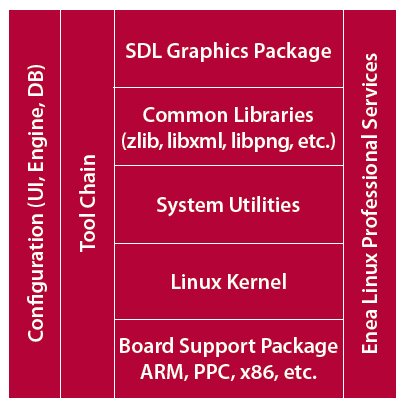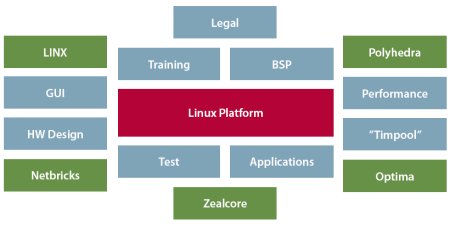Service offers a “jump-start” embedded Linux platform
May 7, 2009 — by Eric Brown — from the LinuxDevices Archive — 4 viewsSwedish telecom software firm Enea announced a services-based Linux development platform to jump-start development of embedded Linux projects. The Enea Embedded Linux Project Framework (ELPF) offers “core components, tools, and services common to virtually all embedded Linux projects in a single, one-stop package,” says the company.
ELPF provides a custom-fit, built-to-order embedded Linux platform that combines “an efficient Linux software foundation,” a modular build environment, and professional services, including integration and development resources, says the company. Application-specific components, including security software and web services, are also said to be available.

ELPF architecture
ELPF is the latest of a number of services-oriented hybrid Linux development platforms that have been introduced in the last few months, as alternatives to traditional do-it-yourself (DIY) development approaches on the one hand and commercial embedded Linux distributions such as MontaVista Linux and Wind River Linux on the other. Somewhat similar new services include the TimeSys LinuxLink 3.0 subscription service, which was upgraded with personalized Web 2.0 services and an automated “Factory” build platform, and Embedded Alley's open-ended “Embedded Alley Development System for Linux-based Devices” software development kit (SDK), backed up by a “Junction” collaboration site.
Enea's arguments for a hybrid approach are similar to those offered by TimeSys and EA. The DIY approach demands tedious assembling, building, and testing steps. Commercial distros, meanwhile, require extensive editing down of the software to select the desired components. Either solution slows development time, says Enea.
ELPF appears to have a broader focus than Enea's telecom-oriented Enea Accelerator Platform, which is designed for IP-based services built on carrier-grade infrastructure. The soup-to-nuts Accelerator integrates a variety of telecom-oriented software, and is built on MontaVista or Wind River Linux kernel distributions. The major component is Enea's high-availability Element middleware, which is designed for heterogeneous telecom environments that mix Linux with Enea's own OSE and OSEck real-time operating systems (RTOSes).
Although billed as a universal embedded Linux platform, ELPF customers may well be drawn primarily from Accelerator's networking and telecom oriented customers. In addition, there are some Enea packages shared by Accelerator and ELPF. These include the Polyhedra lightweight, Linux-ready SQL RDBMS (relational database management system), and the Linx interprocess communications (IPC) services software for distributed telecom systems (see diagram below).

Some major ELPF-accessible components
(Click to enlarge)
The ELPF platform contains the following components, says Enea:
- Configuration database, engine and UIs
- Tool-chain and board support package (BSP) support for leading CPU architectures, including ARM, PPC, and x86
- Bootloader
- Busybox system utilities
- SDL-based graphics platform
- Libraries such as zlib, libxml, and libpng
Enea Linux Competence Center services that are available to ELPF platform users are said to include:
- BSP customization
- Application development
- Electronics development
- Testing
- GUI development
- Troubleshooting
- Open source management
- Open source legal advice
- Training
Moving toward a services model
When Enea announced version 2.0 of Accelerator last June, Enea director of Product Marketing Chris Lanfear explained to LinuxDevices that Enea was pushing more into application development and professional services. The company has been especially interested in improving support for higher-level networking protocols.
“We need to improve our support for next-generation-network protocols, such as SIP and Diameter,” said Lanfear at the time. Toward that end, in April 2008, the company acquired a French supplier of portable protocol stacks called Netbricks, which is listed as a component of the ELPF diagram above. In May, meanwhile, Enea acquired IP Devel, a Romanian company specializing in embedded systems development and advanced test services.
While much of Enea's focus in recent years has been on Linux, the company's proprietary RTOS, called OSE, is still the company's primary business. OSE is deployed in the software-defined baseband radios of approximately half of the world's 3G mobile phones and base stations, says the company.
Stated Anders Toernqvist, director of the Enea Linux Competence Center, “The inspiration for the ELPF came from working extensively with clients who engaged us to optimize the commercial distributions they had purchased. We saw that typically only a fraction of a commercial distribution is used in any given project. It is simply not cost effective for many projects to use a full commercial distribution. [ELPF] acts as the perfect quick-start for many new Linux projects regardless of size or product complexity.”
Stated Steve Balacco, director of the Embedded Software and Tools Practice at VDC Research Group, “Embedded Linux is maturing. Developers are now more experienced with Linux and looking for solutions which are optimized for specific development challenges.”
Availability
Enea did not offer details on the pricing or availability of the Enea Embedded Linux Project Framework, but will demonstrate the ELPF on May 15, at 8AM in Kista, Sweden. For more details on the event, interested parties may send an email to anders.tornqvis[email protected].
This article was originally published on LinuxDevices.com and has been donated to the open source community by QuinStreet Inc. Please visit LinuxToday.com for up-to-date news and articles about Linux and open source.